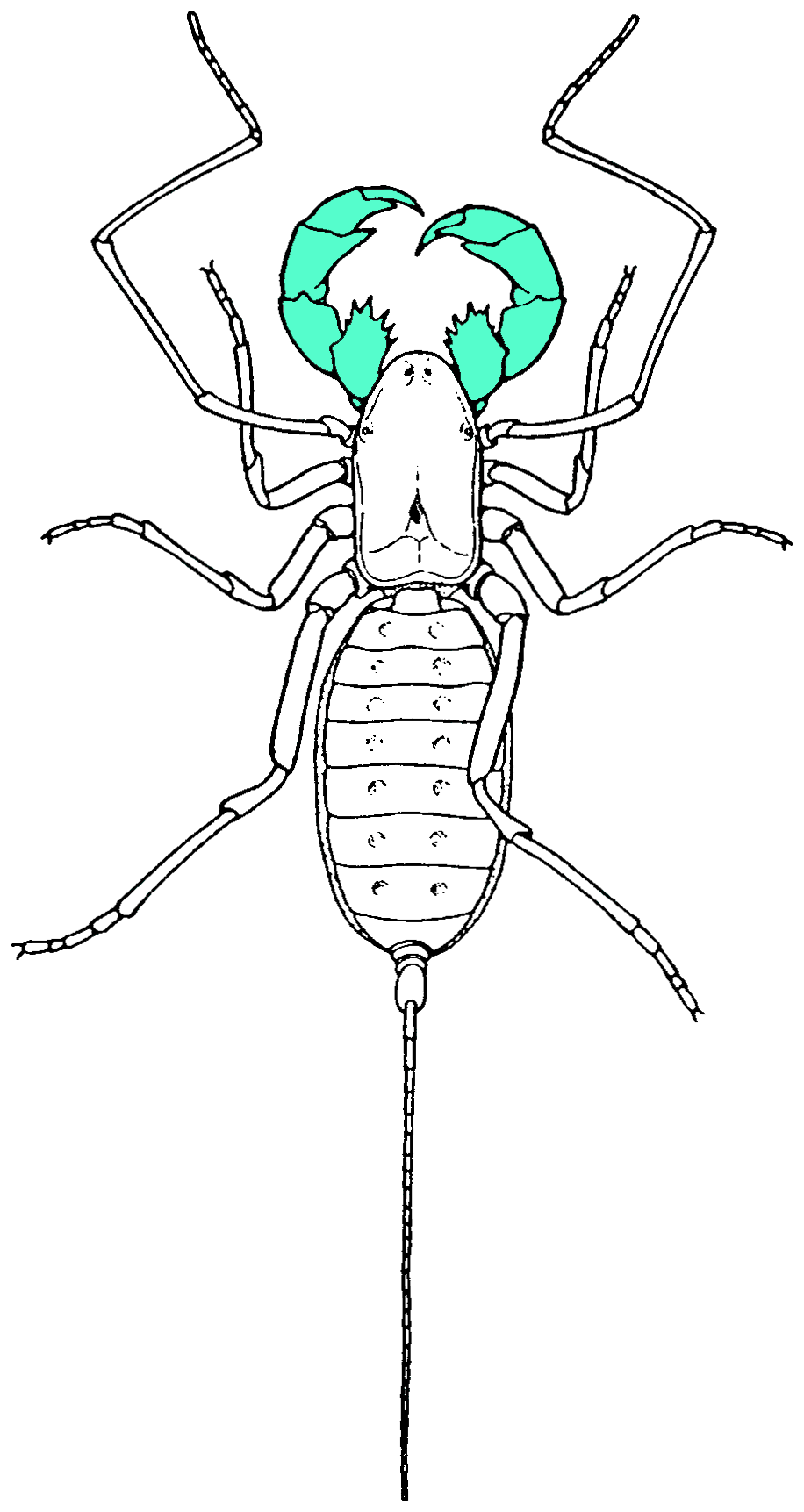|
Argiope Bruennichi
''Argiope bruennichi'', commonly known as the wasp spider, is a species of orb-weaver spider found across Central and Northern Europe, several regions of Asia and Africa and the Azores. Like many other members of the same genus '' Argiope'', this species features distinctive yellow, white and black markings on its abdomen. Web The spider builds a spiral orb web at dawn or dusk, most often in long grass just above ground level. The zigzag-shaped web decoration, named the stabilimentum, is featured at the centre of the orb. Its function is not currently known, though studies have indicated that the webs containing stabilimentia are damaged less often by birds flying through them. When prey gets trapped in the web, the spider immobilizes it by wrapping it in silk. The prey is then bitten and injected with a paralyzing venom and a protein-dissolving enzyme. Wasp spider (Argiope bruennichi) underside, showing stabilimentum.jpg, female on web, showing stabilimentum Wasp spider (Ar ... [...More Info...] [...Related Items...] OR: [Wikipedia] [Google] [Baidu] |
Giovanni Antonio Scopoli
Giovanni Antonio Scopoli (sometimes Latinisation of names, Latinized as Johannes Antonius Scopolius) (3 June 1723 – 8 May 1788) was an Italians, Italian physician and natural history, naturalist. His biographer Otto Guglia named him the "first anational European" and the "Carl Linnaeus, Linnaeus of the Habsburg monarchy, Austrian Empire". Biography Scopoli was born at Cavalese in the Val di Fiemme, belonging to the Prince-Bishopric of Trent, Bishopric of Trent (today's Trentino), son of Francesco Antonio, military commissioner, and Claudia Caterina Gramola (1699-1791), a painter from a patrician family from Trentino. He obtained a degree in medicine at University of Innsbruck, and practised as a doctor in Cavalese and Venice.Newton, Alfred 1881. ''Scopoli's ornithological papers.'' The Willoughby SocietyScanned version/ref> Much of his time was spent in the Alps, Plant collecting, collecting plants and Entomology, insects, of which he made outstanding collections. He spent two ... [...More Info...] [...Related Items...] OR: [Wikipedia] [Google] [Baidu] |
Sexual Dimorphism
Sexual dimorphism is the condition where sexes of the same species exhibit different Morphology (biology), morphological characteristics, including characteristics not directly involved in reproduction. The condition occurs in most dioecy, dioecious species, which consist of most animals and some plants. Differences may include secondary sex characteristics, size, weight, color, markings, or behavioral or cognitive traits. Male-male reproductive competition has evolved a diverse array of sexually dimorphic traits. Aggressive utility traits such as "battle" teeth and blunt heads reinforced as battering rams are used as weapons in aggressive interactions between rivals. Passive displays such as ornamental feathering or song-calling have also evolved mainly through sexual selection. These differences may be subtle or exaggerated and may be subjected to sexual selection and natural selection. The opposite of dimorphism is ''monomorphism'', when both biological sexes are phenotype, ... [...More Info...] [...Related Items...] OR: [Wikipedia] [Google] [Baidu] |
Amino Acid
Amino acids are organic compounds that contain both amino and carboxylic acid functional groups. Although over 500 amino acids exist in nature, by far the most important are the 22 α-amino acids incorporated into proteins. Only these 22 appear in the genetic code of life. Amino acids can be classified according to the locations of the core structural functional groups ( alpha- , beta- , gamma- amino acids, etc.); other categories relate to polarity, ionization, and side-chain group type ( aliphatic, acyclic, aromatic, polar, etc.). In the form of proteins, amino-acid '' residues'' form the second-largest component (water being the largest) of human muscles and other tissues. Beyond their role as residues in proteins, amino acids participate in a number of processes such as neurotransmitter transport and biosynthesis. It is thought that they played a key role in enabling life on Earth and its emergence. Amino acids are formally named by the IUPAC- IUBMB Joint Commi ... [...More Info...] [...Related Items...] OR: [Wikipedia] [Google] [Baidu] |
Chelicerae
The chelicerae () are the arthropod mouthparts, mouthparts of the subphylum Chelicerata, an arthropod group that includes arachnids, horseshoe crabs, and sea spiders. Commonly referred to as "jaws", chelicerae may be shaped as either articulated fangs, or as a type of pincer_(biology), pincers. Some chelicerae, such as those found on nearly all spiders, are hollow and contain (or are connected to) venom glands, used to inject venom into prey or a perceived threat. Both pseudoscorpions and Opiliones , harvestmen have additional structures on their chelicerae that are used for grooming (papillae in pseudoscorpions, cheliceral teeth in Opiliones). In ''Paratrechalea'', males and females have shown to have a chelicerae dimorphism, because the chelicerae is used as a mating signal for females. Types Chelicerae can be divided into three kinds: jackknife chelicerae, scissor chelicerae, and three-segmented wikt:chelate, chelate chelicerae. Jackknife chelicerae The jackknife chelicer ... [...More Info...] [...Related Items...] OR: [Wikipedia] [Google] [Baidu] |
Behavioral Ecology And Sociobiology
''Behavioral Ecology and Sociobiology'' is a peer-reviewed scientific journal covering quantitative, empirical, and theoretical studies in the field of analysis of animal behavior at the levels of the individual, population, and community. Abstracting and indexing The journal is abstracted and indexed in: According to the ''Journal Citation Reports'', the journal has a 2020 impact factor The impact factor (IF) or journal impact factor (JIF) of an academic journal is a type of journal ranking. Journals with higher impact factor values are considered more prestigious or important within their field. The Impact Factor of a journa ... of 2.980. References External links {{Official website, https://link.springer.com/journal/265 Ecology journals Ethology journals Academic journals established in 1976 Springer Science+Business Media academic journals Monthly journals English-language journals ... [...More Info...] [...Related Items...] OR: [Wikipedia] [Google] [Baidu] |
Sexual Cannibalism
Sexual cannibalism is when an animal, usually the female, Cannibalism, cannibalizes its mate prior to, during, or after Copulation (zoology), copulation. This trait is observed in many arachnid orders, several insect and crustacean clades, Gastropoda, gastropods, and some snake species. Several hypotheses to explain this seemingly paradoxical behavior have been proposed, including the adaptive foraging hypothesis, aggressive spillover hypothesis and mistaken identity hypothesis. This behavior is believed to have evolved as a manifestation of sexual conflict, occurring when the reproductive interests of males and females differ. In many species that exhibit sexual cannibalism, the female consumes the male upon detection. Females of cannibalistic species are generally hostile and unwilling to mate; thus many males of these species have developed adaptive behaviors to counteract female aggression. Prevalence Sexual cannibalism occurs among insects, arachnids and Amphipoda, amphipods. ... [...More Info...] [...Related Items...] OR: [Wikipedia] [Google] [Baidu] |
Sex Ratio
A sex ratio is the ratio of males to females in a population. As explained by Fisher's principle, for evolutionary reasons this is typically about 1:1 in species which reproduce sexually. However, many species deviate from an even sex ratio, either periodically or permanently. These include parthenogenic and androgenetic species, periodically mating organisms such as aphids, some eusocial wasps, bees, ants, and termites. Types In most species, the sex ratio varies according to the age profile of the population. It is generally divided into four subdivisions: * — ratio at fertilization * — ratio at birth * — ratio in sexually mature organisms ** The tertiary sex ratio is equivalent to the (ASR), which is defined as the ratio of adult males to females in a population. ** The operational sex ratio (OSR) is the ratio of ''sexually active'' males to females in a population, and is therefore derived from a subset of the individuals included when calculating the ASR. ... [...More Info...] [...Related Items...] OR: [Wikipedia] [Google] [Baidu] |
Monogamy In Animals
Some animal species have a monogamous mating system, in which pairs bond to raise offspring. This is associated, usually implicitly, with sexual monogamy. Monogamous mating Monogamy is defined as a pair bond between two adult animals of the same species. This pair may cohabitate in an area or territory for some duration of time, and in some cases may copulate and reproduce with only each other. Monogamy may either be short-term, lasting one to a few seasons or long-term, lasting many seasons and in extreme cases, life-long. Monogamy can be partitioned into two categories, social monogamy and genetic monogamy which may occur together in some combination, or completely independently of one another.Ophir, Alexander G., Phelps, Steven M., Sorin, Anna Bess & O. Wolff, J. (2008)Social but not genetic monogamy is associated with greater breeding success in prairie voles/ref> As an example, in the cichlid species '' Variabilichromis moorii'', a monogamous pair will care for eggs and y ... [...More Info...] [...Related Items...] OR: [Wikipedia] [Google] [Baidu] |
Behavioral Ecology (journal)
''Behavioral Ecology'' is a bimonthly peer-reviewed scientific journal published by Oxford University Press on behalf of the International Society for Behavioral Ecology. The journal was established in 1990. Scope ''Behavioral Ecology'' publishes empirical and theoretical papers on a broad range of topics related to behavioural ecology, including ethology, sociobiology, evolution, and ecology of behaviour. The journal includes research at the levels of the individual, population, and community on various organisms such as vertebrates, invertebrates, and plants. According to the ''Journal Citation Reports'', the journal has a 2020 impact factor The impact factor (IF) or journal impact factor (JIF) of an academic journal is a type of journal ranking. Journals with higher impact factor values are considered more prestigious or important within their field. The Impact Factor of a journa ... of 2.671, ranking it 22nd out of 175 journals in the category "Zoology". Article ... [...More Info...] [...Related Items...] OR: [Wikipedia] [Google] [Baidu] |
Moulting
In biology, moulting (British English), or molting (American English), also known as sloughing, shedding, or in many invertebrates, ecdysis, is a process by which an animal casts off parts of its body to serve some beneficial purpose, either at specific times of the year, or at specific points in its life cycle. In medieval times, it was also known as "mewing" (from the French verb "muer", to moult), a term that lives on in the name of Britain's Royal Mews where the King's hawks used to be kept during moulting time before becoming horse stables after Tudor times. Moulting can involve shedding the Epidermis (skin), epidermis (skin), pelage (hair, feathers, fur, wool), or other external layer. In some groups, other body parts may be shed, for example, the entire exoskeleton in arthropods, including the wings in some insects. Examples In birds In birds, moulting is the periodic replacement of feathers by shedding old feathers while producing new ones. Feathers are dead struct ... [...More Info...] [...Related Items...] OR: [Wikipedia] [Google] [Baidu] |
Pedipalp
Pedipalps (commonly shortened to palps or palpi) are the secondary pair of forward appendages among Chelicerata, chelicerates – a group of arthropods including spiders, scorpions, horseshoe crabs, and sea spiders. The pedipalps are lateral to the chelicerae ("jaws") and anterior to the first pair of walking legs. Overview Pedipalps are composed of six segments or articles. From the proximal end (where they are attached to the body) to the distal, they are: the coxa, the Arthropod leg#Trochanter, trochanter, the Arthropod leg#Femur, femur, the short Glossary_of_spider_terms#patella, patella, the Glossary_of_spider_terms#tibia, tibia, and the Arthropod_leg#Tarsus, tarsus. In spiders, the coxae frequently have extensions called Glossary_of_spider_terms#maxilla , maxillae or gnathobases, which function as mouth parts with or without some contribution from the coxae of the anterior arthropod leg, legs. The limbs themselves may be simple tactile organs outwardly resembling the legs ... [...More Info...] [...Related Items...] OR: [Wikipedia] [Google] [Baidu] |






